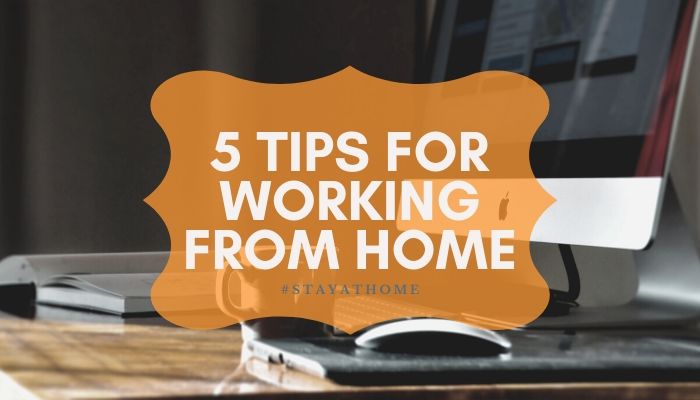5 Tips for Working from Home

It’s Easter weekend. As per the pattern over the last couple of years, we’ve had some snow here in Montreal. Yes, snow. It’s just winter clinging on by its fingernails. Soon it’ll be spring, which usually means I shrug off my hermit life and emerge into the sunshine. It’s a bit different this year, given the directives to stay home. I can still go for walks though, right?
Boy, I hope so.
Speaking of staying home – many, if not all, of us are now working from home. If you’ve never worked from home before, this might be a huge transition for you. And maybe, now that you’re a couple weeks in, you might be finding it more and more difficult to stay sane. This is completely normal. Trust me, I’ve been through it.
I started working from home in 2015 and it took awhile for me to get my bearings. I’ve picked up and developed a few strategies to battle cabin fever – especially with regards to those little things we take for granted when we go to the office every way. Read on so that you can be productive at home after the long weekend.
Daily Transit Trip
As annoying as daily transit and travel may be, I realized after I made the switch to a home-office just how valuable that time truly is. We take our daily transit for granted. As much as we complain about the bustle and crowds on the bus or metro (subway), that time – however much it is for you – helps our brains switch from “waking up” to “ready for work”.
How to adjust at home:
After you’ve gotten up, dressed and complete your usual morning stuff, and before you sit down at your computer, set a timer for 5, 10, 15 minutes… however many minutes you want. Sit down in a chair in a different room (ex. If you work in your living room, sit at your kitchen table…) and do whatever it is you normally do on transit. If you scroll through social media, do that. If you zone out and daydream, do that. Listen to music on your headphones? Do that! (on your headphones too!) We’re creatures of habit, and giving our brain those recognizable signals that you’re “heading” to work, should in theory help you focus more when you sit down to do the actual work.
(Note: I am not a psychologist or sociologist or human behaviourist or any of those things, so I’m basing this on information I’ve gleaned and retained over the course of my life…)
Focussing during the day
When you go an office, you have a set space dedicated to work. You have people around you who are also working (at least, they should be). The environment is designed to make sure you can focus. At home, not so much. Quite the opposite. The environment is (I hope) designed to help you relax.
I’ve been told by many people that they wouldn’t be able to work from home because they don’t have the discipline to actually work. I understand. Trust me, I understand. I honestly don’t think I actually have the discipline to work from home either… Just a healthy respect for deadlines and an overwhelmingly great ability to pull things together after procrastinating for hours. I honestly think that it’s not a lack of discipline – I mean, you get work done at the office right? It’s more an unfamiliar environment designed to make you comfortable, rather than focussed.
How to adjust at home:
There’s no “right” way to focus, or set yourself up so you can work diligently. Everyone is different. However, here are a few guidelines that should help.
Have a set “work” space – This is where you do your work and nothing else. During work hours, you’re at work – if it’s not something you can do when you’re at the office, it’s not time for you to do it now. It’s not time for chores. You can do those on the weekend. It’s not time to watch TV (unless you’re capable of working while watching TV). You can watch TV later. It’s work time.
First thing when you get to your desk, plan out your day – write down everything you want to do that day. Check it off as you do it. Sounds basic (and it is) but it really does work. If you can’t put down specific tasks, that’s fine. Give yourself an hourly goal. Ex. “I’ll work on X for 1 hour”. Also, if you don’t get everything done that you planned, don’t be too hard on yourself. C’est la vie. And if your bosses get mad, well. They’re jerks. (Unless that project was due yesterday and you’re being lazy… that’s on you, my friend).
I’m sharing a page from my day planner with everyone so you can stay on top of your work and feel a bit more organized. Look for the link at the bottom of this article.
Take breaks – When you’re at the office, you would probably get up to get coffee, or go to the bathroom, or chat about something with a colleague. When you work from home, it’s easy to forget that you can do these things. I personally have had moments where I realized it had been two hours since I’d gotten up. You should get up at least once an hour… if not once every 30 minutes. So, plan in little stretch breaks – I like to do them between projects… unless the project is going to take hours. Give your brain a little shake. It’ll help you focus on the next project.
Keep your beverage full – I’m referring to water and coffee and tea and all that here. Do this for two reasons: one, you’ll have to go to the bathroom more often so yay! Stretch breaks! And two, you’ll probably get thirsty. Oh and three, staying hydrated will help combat the boredom munchies… that’s when you eat snacks and other foodstuffs because you’re just so alone.
Leaving work
Your daily transit home is equally as important as your daily transit to work. This time allows you to decompress and gives your brain the signals it needs to say “hey, I’m not at work anymore”. I miss these rides. I miss these designated, self-imposed moments where I’m forced to switch gears. I miss not having my work at home. You’re probably missing these things too.
How to adjust at home:
Same as with the morning transit – set your alarm then sit yourself down in a space separate from your work, put on your headphones, zone out/browse social media/play Animal Crossing… whatever it is you do in transit..
And, when your alarm goes off DO NOT GO BACK TO WORK. Don’t think about work. Don’t check your work emails on your phone. If you remember something that you needed to do, DON’T DO IT. It’s not that urgent, I promise you. Everyone will be fine if you do it tomorrow, during work hours.
This was the hardest lesson for me. When I first started working from home, I would work on the couch, in the kitchen, in my office, in my bedroom (ok, not in my bedroom). I never let myself turn work OFF, so I could focus on life. I ended up burning out (obviously). So, turn it off. Work will be there tomorrow.
Sunshine & exercise
Depending on where you are in the world, there may be rules in place that are designed to keep you safe… and inside. Sunshine is very important. Greenery is also very important (For a 2017 Quench Magazine article, I spoke with colour experts about the colour green; it was very interesting and you can read it here).
Not having your daily dose of outdoors-i-ness – no matter how small that dose usually is – can make cabin fever worse. I’m getting antsy just thinking about it, and I pretty much never go outside if I can help it!
Also, those daily walks to your vehicle or the bus stop (again, no matter how short or long) are essential for your health. Your body has gotten used to that specific amount of exercise every day. If you stop doing that now, your body may start feeling sluggish or beaten down. It’s important that you give it something to do that’s equal to your daily walks.
How to adjust at home:
If you have a balcony, give yourself five minutes every hour (or two hours or whatever interval you decide) to go outside and breath in the fresh air. Do it even when it’s raining or cold. If you don’t have a balcony – and your regional quarantine rules say you cannot go for walks – then open your window as wide as it’ll go and sit on the sill or in the sunshine for five minutes. Or one minute. However long you need to feel connected to the outside. It’s not the same, at all, but it’ll help you hold on until you can go outside.
How to adjust at home, part 2:
Yoga. Pilates. Exercise videos. Walking up and down your stairs. Walking around your house. Whatever works for you, do it. Get that exercise. Don’t let social distancing and self isolation ruin your summer bod (or whatever the cool kids are saying these days).
Talking to people
Human beings, by nature, are social creatures. We need to interact with one another. As an introvert, I can go long periods without seeing a person and be ok… this isn’t a big deal for me. I think the longest I’ve gone without seeing a real, live person was two weeks and by the end of that I was admittedly a bit crazy (that crazy never truly went away). I don’t have to worry about that anymore though, since my husband lives with me and now I get to see him every day.
Whenever I need to socialize, I text one of my friends. I love text-based communication. It fulfills my need to connect while also respecting my hatred of actually talking out loud. If, however, you’re not a text-based connector, like myself, not being able to see and hear people can weigh on you.
How to adjust at home:
Set up video chats with people. Do you and a coworker have daily water cooler chats when you’re at the office? Schedule a “water cooler” chat via the interwebs! Maybe you and your friends get together for Happy Hour once a week… do the same thing, only on your computer and from your respective homes! Call or video chat with your mother (or father, or grandparents, or siblings, or other loved ones). Trust me, they want you to call. I should probably call mine right now, actually.
Well, those are my five easy ways to adjust while working from home. Stay positive and remember, this isn’t permanent. This too shall pass. And by this time next year, we’ll all be wishing we could stay home more often.
I’m in the midst of finalizing the design and production process of my very first product – the day planner. I’ve heard that the “weekly” tracking pages have helped some of my friends manage their lives. I’ve decided to share this with everyone, for free, because being organized very much helps keep the crazy away.
Click here to download a PDF of my “weekly” tracking page.
How to use this file:
- Download the PDF.
- Print (should print in regular letter size).
- Add the week’s date where it says “This week” & / or put the individual day’s dates in the blank spaces provided.
- Fill in your appointments & due dates on the left-hand side.
- Fill in your week’s work-related tasks in the “must do” section.
- Fill in your chores & household tasks in the “should do” section.
- X out the boxes as you complete tasks.
Not a paper person? You can fill this out digitally – just use Adobe Reader’s “Fill & Sign” function to complete the sections.

 Previous Post
Previous Post Next Post
Next Post
[…] 5 Tips for Working from Home […]